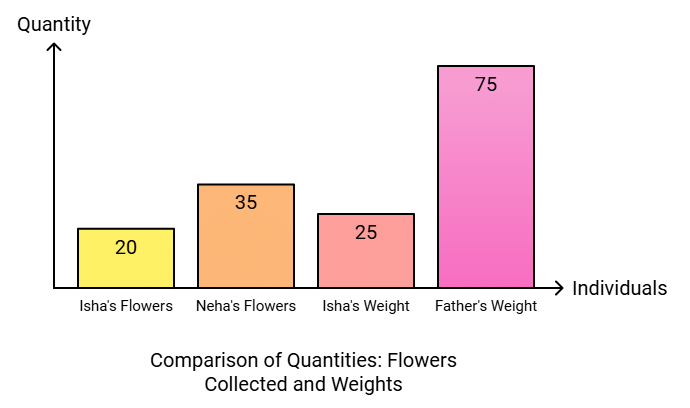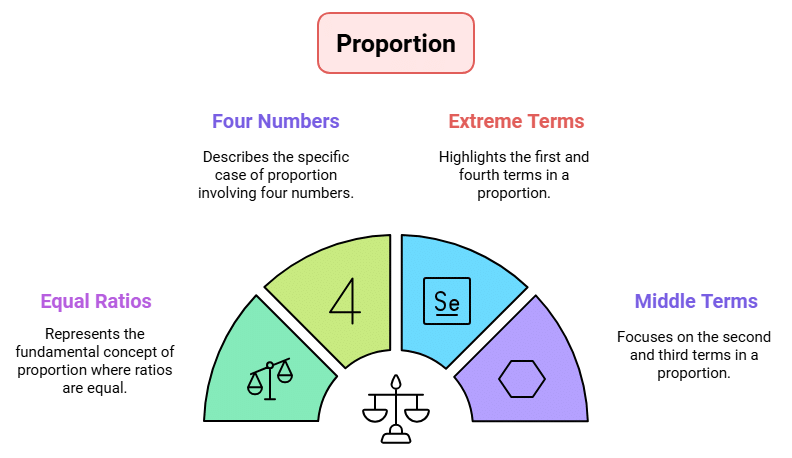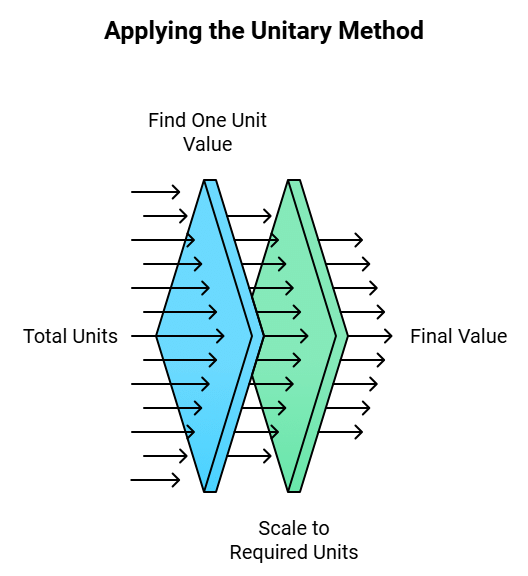Class 6 Exam > Class 6 Notes > Maths Olympiad Class 6 > NCERT Summary: Ratio & Proportion
Ratio and Proportion Summary Class 6 Maths Chapter 12
Ratio
- The ratio of two non-zero numbers a and b is the fraction a/b and we write it as a : b read as ‘a is to b’.
- In the ratio a : b, we call a the first term or antecedent and b the second term or consequent.
- Equivalent ratios : On multiplying (or dividing) each term of a ratio by the same non-zero number, we get a ratio equivalent to the given ratio.
- Ratio in simplest form : The ratio a : b is said to be in the simplest form if the HCF of a and b is 1.

Methods of comparing quantities
Comparison by taking difference
- For comparing quantities of the same type, we commonly use the method of taking difference between the quantities. For example: Isha and Neha collected flowers for scrap notebook. Isha collected 20 flowers and Neha collected 35 flowers. So, we may say that Neha collected 35 - 20 = 15 flowers more than Isha.
- Some times the comparison by difference does not make better sense than the comparison by division.
Comparison by Division
- The comparison of two numbers or quantities by division is known as the ratio. Symbol ':' is used to denote ratio.
- For example, Isha’s weight is 25 kg and her father’s weight is 75 kg. We say that Isha’s father’s weight and Isha’s weight are in the ratio 3 : 1.

Question for NCERT Summary: Ratio & ProportionTry yourself: What is the ratio between the number of apples and the number of oranges?View Solution
Proportion
- If two ratios are equal, we say that they are in proportion and use the symbol ‘::’ or ‘=’ to equate the two ratios.
- If two ratios are not equal, then we say that they are not in proportion.
Four numbers in proportion
- Four numbers a, b, c, d are said to be in proportion if a : b = c : d and we write a : b : : c : d. We read it as ‘a is to b as c is to d’.
- Here a, b, c, d are respectively known as first, second, third and fourth terms of the given proportion.
- The 1st and 4th terms are called the extreme terms or extremes.
- The 2nd and 3rd terms are called the middle terms or means.
- In a proportion a : b : : c : d, we always have (a × d) = (b × c). product of extremes = product of means.

Unitary Method
- The method in which first we find the value of one unit and then the value of the required number of units.
- For example, the cost of 6 caps is 210. Find the cost of 4 caps. The cost of 6 caps = 210
∴ Cost of 1 cap = 210/6 = 35
Hence, cost of 4 caps = 35 × 4 = 140.

The document Ratio and Proportion Summary Class 6 Maths Chapter 12 is a part of the Class 6 Course Maths Olympiad Class 6.
All you need of Class 6 at this link: Class 6
|
6 videos|117 docs|60 tests
|
FAQs on Ratio and Proportion Summary Class 6 Maths Chapter 12
| 1. What is a ratio and how is it expressed? |  |
Ans.A ratio is a way to compare two quantities by division. It is expressed as a fraction or using a colon. For example, if there are 2 apples and 3 oranges, the ratio of apples to oranges can be expressed as 2:3 or as the fraction 2/3.
| 2. How do you simplify a ratio? |  |
Ans.To simplify a ratio, you divide both terms of the ratio by their greatest common divisor (GCD). For example, to simplify the ratio 8:12, you find the GCD of 8 and 12, which is 4. Dividing both terms by 4 gives you the simplified ratio of 2:3.
| 3. What is the difference between a ratio and a proportion? |  |
Ans.A ratio is a comparison of two quantities, while a proportion states that two ratios are equal. For example, if we say 1:2 and 2:4 are proportions, we are indicating that the ratio of 1 to 2 is equal to the ratio of 2 to 4.
| 4. How can proportions be solved? |  |
Ans.Proportions can be solved using cross-multiplication. For example, if you have the proportion a/b = c/d, you can cross-multiply to get ad = bc. This equation can then be used to find the unknown value.
| 5. What are some real-life applications of ratios and proportions? |  |
Ans.Ratios and proportions are used in various real-life situations such as cooking (adjusting ingredient quantities), finance (calculating interest rates), and scaling models (maintaining the same proportions). They help in making comparisons and understanding relationships between quantities.
Related Searches

















